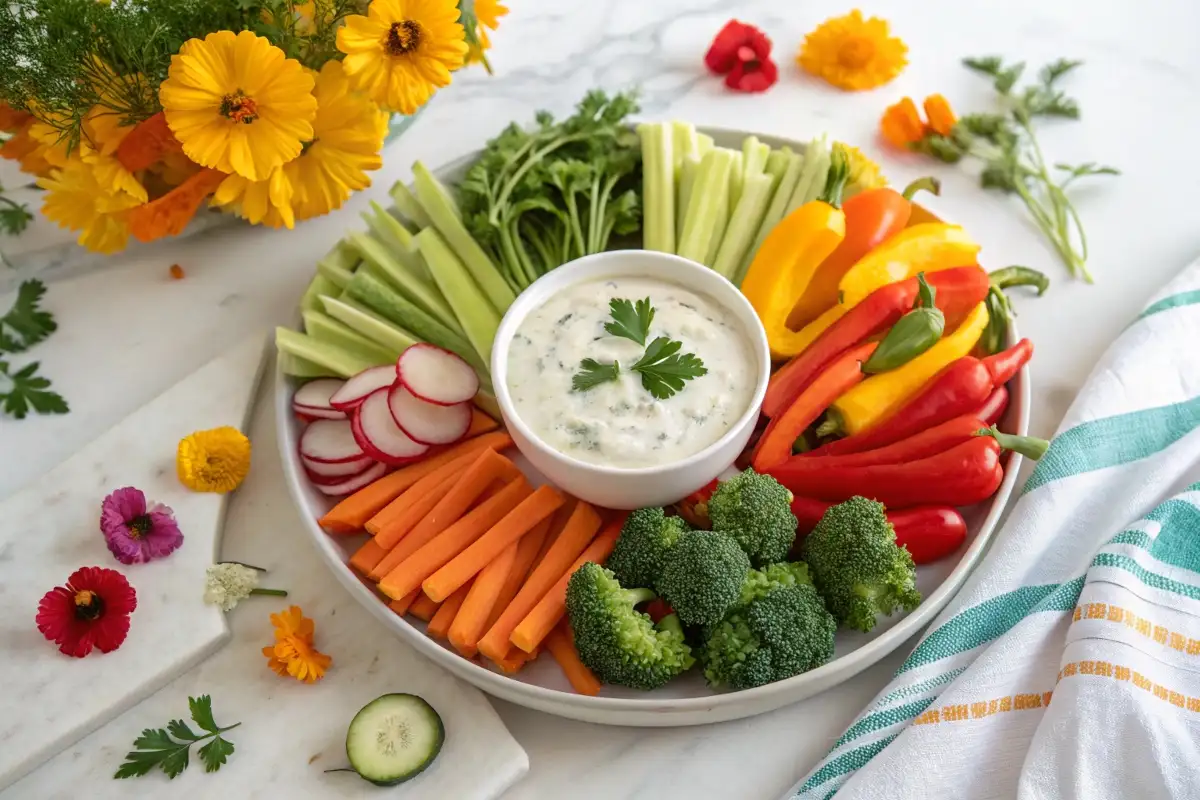Planning the perfect veggie tray might sound simple, but there’s more to it than meets the eye. A well-thought-out veggie tray is not only a visual centerpiece but also a versatile, healthy option for gatherings of all kinds. Whether you’re hosting a casual get-together, celebrating the holidays, or preparing a quick snack, a beautifully arranged veggie tray can steal the spotlight.
In this guide, we’ll walk you through everything you need to know—from picking the freshest vegetables to storing your masterpiece. You’ll also discover fun ways to arrange your tray, unique dip ideas, and clever tips for making it a crowd-pleaser. Let’s dive in!
Introduction to Veggie Trays
What Makes a Veggie Tray a Must-Have for Gatherings?
A veggie tray is a simple yet striking platter of raw, fresh vegetables served with complementary dips. It’s a go-to option for parties, potlucks, and even everyday snacks. Traditionally, these trays feature a mix of colorful veggies like carrots, celery, and bell peppers arranged neatly for easy grabbing. But don’t stop there! With a little creativity, your veggie tray can be as unique as your event.
Why Veggie Trays Are Growing in Popularity
In recent years, veggie trays have become a must-have at gatherings, and it’s no wonder why. With growing health-consciousness and dietary preferences, they cater to everyone—from vegans to gluten-free eaters. Plus, they’re super versatile. Want a snack for kids? A veggie tray works. Need a healthy option for the office party? You guessed it—a veggie tray saves the day! Its visual appeal and health benefits make it a favorite choice for hosts and guests alike.
Benefits of Serving a Veggie Tray
Health Benefits of a Fresh Veggie Tray
One of the best things about a veggie tray is how healthy it is. Packed with vitamins, minerals, and fiber, fresh vegetables are a simple way to offer guests a nutritious option. Snacking on raw vegetables like carrots, broccoli, and cucumbers helps maintain a balanced diet and promotes overall health. Plus, their crunchiness makes them super satisfying! Compared to greasy chips or heavy appetizers, a veggie tray is light, refreshing, and guilt-free.
Catering to All Guests with a Veggie Platter
With dietary restrictions and preferences becoming more common, it’s hard to please everyone. Thankfully, a well-prepared veggie tray works for just about anyone. Whether your guests are vegan, gluten-free, or simply looking for a low-calorie option, a veggie tray fits the bill. And the best part? You can add a variety of veggies to suit different tastes—everyone gets to enjoy something!
How Veggie Trays Make Hosting Easier
Hosting can be stressful, but a veggie tray keeps things simple. It’s easy to assemble ahead of time, requires minimal cooking, and doesn’t need to be kept warm. Just arrange the vegetables, whip up a dip, and you’re all set. Plus, the tray is reusable—you can refill it throughout the event, saving time and effort. With so much convenience, it’s no wonder veggie trays are a go-to choice for busy hosts.
Choosing the Best Vegetables for Your Veggie Tray
Top Vegetables to Include in Your Veggie Tray
Choosing the right vegetables is key to a great veggie tray. Some classics you can’t go wrong with include baby carrots, celery sticks, cherry tomatoes, and bell pepper slices. These veggies are not only delicious but also easy to eat without making a mess. For a little variety, you can add snap peas, radishes, or even zucchini sticks to your mix.
Seasonal Veggies for the Perfect Platter
Using seasonal vegetables ensures maximum freshness and flavor. In the summer, think of crisp cucumbers and sweet cherry tomatoes. During winter, go for hearty options like cauliflower and broccoli. Seasonal produce isn’t just tastier—it’s also more affordable. Plus, it’s an easy way to keep your veggie tray exciting and aligned with the time of year.
Add Color and Texture to Your Veggie Tray
A visually appealing veggie tray is all about contrast. Combining vibrant colors like orange carrots, red peppers, and green broccoli makes your tray pop. Additionally, mix up the textures—combine crunchy vegetables like snap peas with softer ones like cucumber slices. This not only makes the tray more enjoyable to eat but also draws people in. Remember, people eat with their eyes first!
Preparing and Arranging Your Veggie Tray
Easy Tips for Prepping Vegetables for a Veggie Tray
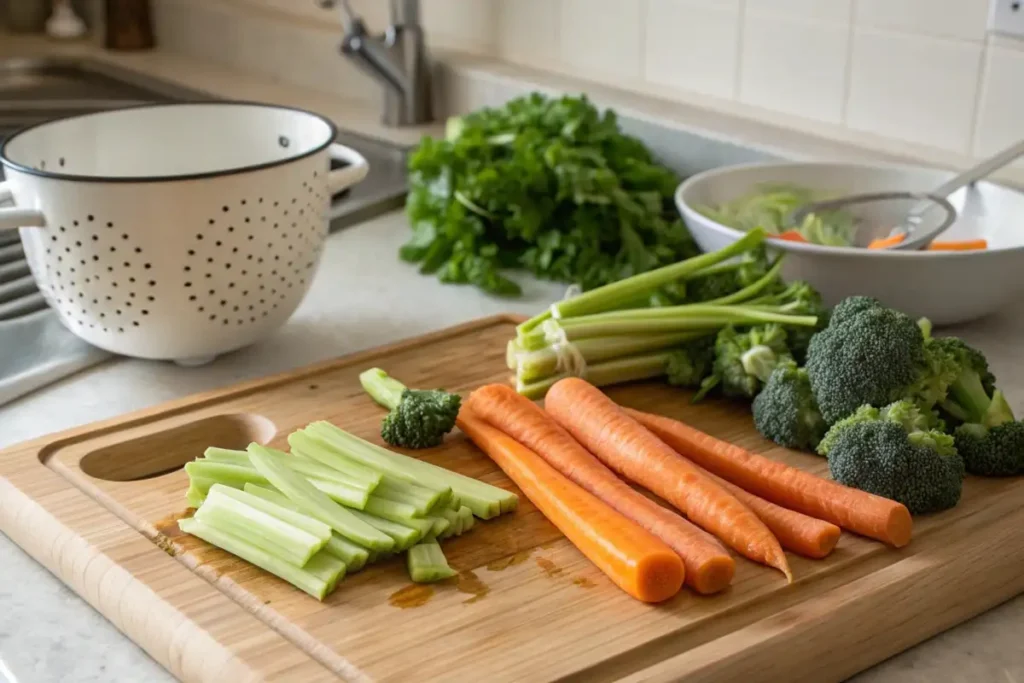
First and foremost, always wash your vegetables thoroughly under cold running water to remove any dirt or pesticides. For firmer veggies like carrots and celery, a gentle scrub with a vegetable brush can be beneficial. After washing, pat them dry with a clean towel to prevent excess moisture, which can make them soggy.
When it comes to cutting, aim for uniformity. Slice vegetables into bite-sized pieces that are easy to handle. For instance, cut carrots and celery into sticks about 3-4 inches long. Bell peppers can be sliced into thin strips, while broccoli and cauliflower should be broken into small florets. Uniform pieces not only look appealing but also ensure even dipping.
Creative Ways to Arrange Your Veggie Platter
Arranging your veggie tray can be a fun and artistic endeavor. Start by placing a bowl of dip in the center of your platter. Then, group each type of vegetable around the dip in sections, creating a vibrant, colorful display. For a more creative touch, consider arranging the veggies in concentric circles or in the shape of a rainbow to highlight the variety of colors.
Additionally, using a tiered serving tray can add dimension and make your presentation stand out. Don’t hesitate to play with different layouts until you find one that pleases your eye.
Decorative Ideas to Elevate Your Veggie Tray
To elevate the visual appeal of your veggie tray, incorporate decorative elements. Fresh herbs like parsley or dill can be sprinkled over the vegetables for a pop of color and added fragrance. Edible flowers, such as nasturtiums or pansies, can also be used to adorn the tray, making it look more festive.
Moreover, consider using hollowed-out bell peppers or cabbage heads as unique containers for your dips. This not only adds a rustic charm but also reduces the need for extra dishware.
Remember, the goal is to make your veggie tray as inviting as possible, encouraging guests to dig in and enjoy the fresh, healthy offerings.
Delicious Dips for Your Veggie Tray
Classic Dip Options for Your Veggie Tray
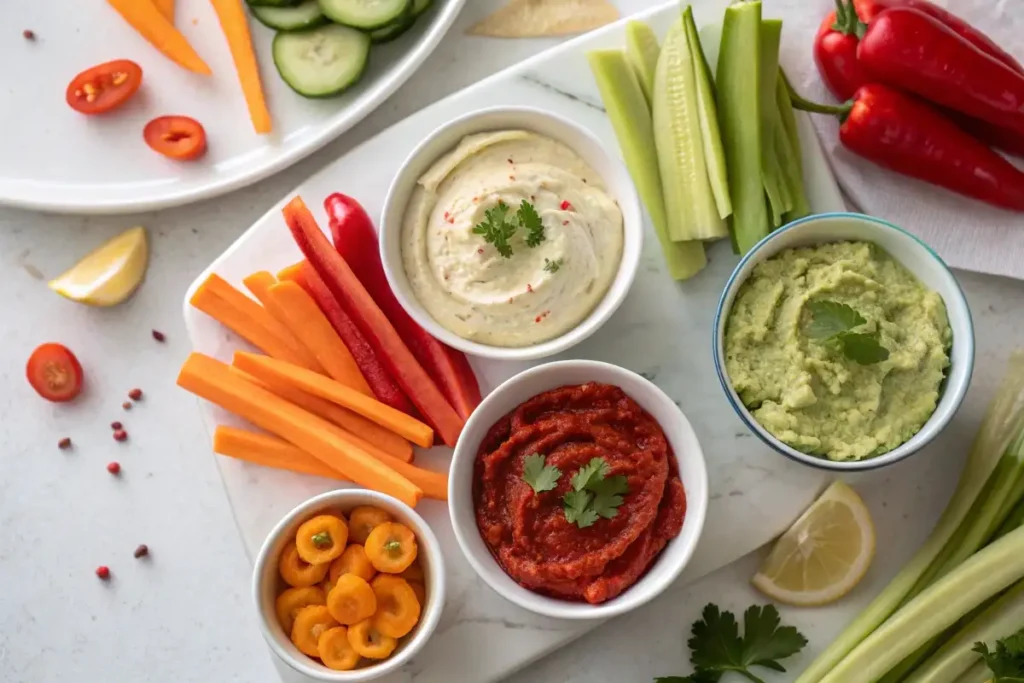
A veggie tray isn’t complete without delicious dips. Classic options like ranch dressing and hummus are perennial favorites. Ranch offers a creamy, tangy flavor that pairs well with most vegetables, while hummus provides a rich, savory taste, especially when made from scratch.
To make a simple ranch dip, combine sour cream, mayonnaise, and a blend of herbs like dill, parsley, and chives. For homemade hummus, blend cooked chickpeas with tahini, lemon juice, garlic, and olive oil until smooth.
Healthy Dip Recipes to Pair with Your Veggie Tray
For those seeking healthier options, consider yogurt-based dips or guacamole. A Greek yogurt dip mixed with herbs and a squeeze of lemon provides a protein-rich, low-fat alternative to traditional creamy dips. Guacamole, made from mashed avocados, lime juice, and a touch of salt, offers healthy fats and a fresh taste that complements crunchy veggies.
Another option is a simple salsa made from diced tomatoes, onions, cilantro, and jalapeños, which adds a zesty kick without added fats.
Best Veggie and Dip Pairings
Pairing the right dip with the right vegetable can enhance the overall tasting experience. For example, the crispness of celery and carrots pairs wonderfully with creamy ranch dip. The robust flavor of broccoli and cauliflower florets complements the richness of hummus. Bell pepper strips and cherry tomatoes shine when dipped in guacamole or salsa.
Offering a variety of dips alongside your veggie tray not only caters to different taste preferences but also encourages guests to try new combinations, making the platter more interactive and enjoyable.
Themed Veggie Trays for Special Occasions
Holiday-Inspired Designs
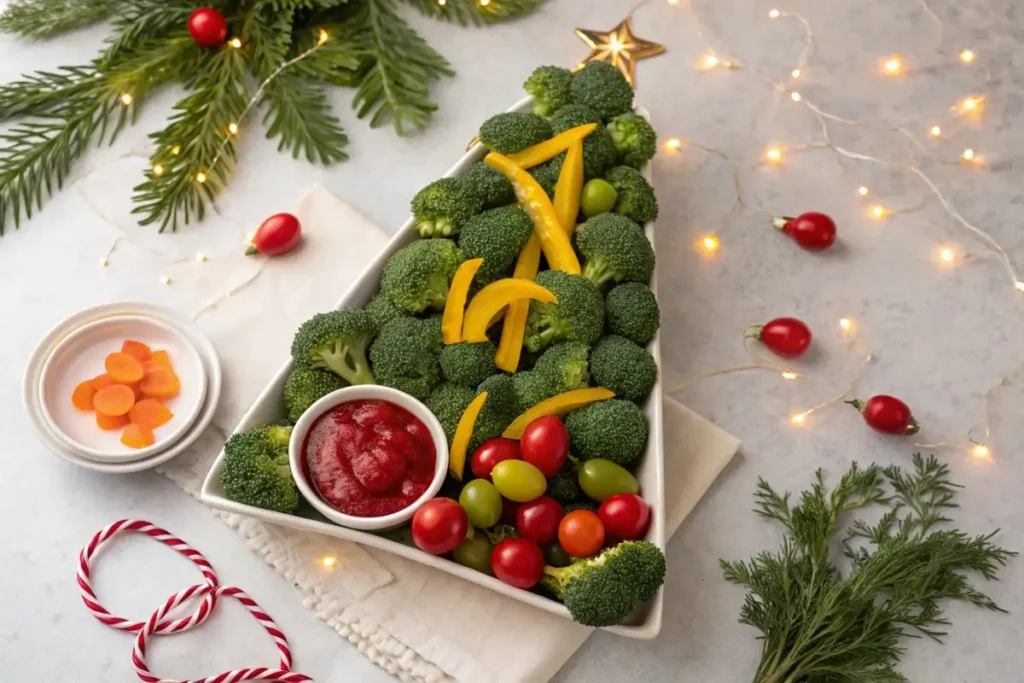
A themed veggie tray can instantly elevate your party spread, especially during the holidays. For Christmas, try arranging your vegetables in the shape of a Christmas tree. Use broccoli florets as the base, cherry tomatoes as ornaments, and thin strips of yellow bell pepper as garlands. For Halloween, create a spooky face using sliced cucumbers, bell peppers, and olives.
These creative designs make your veggie tray not just a snack but also a centerpiece. Guests will love the festive look and be encouraged to dig in.
Kid-Friendly Veggie Trays
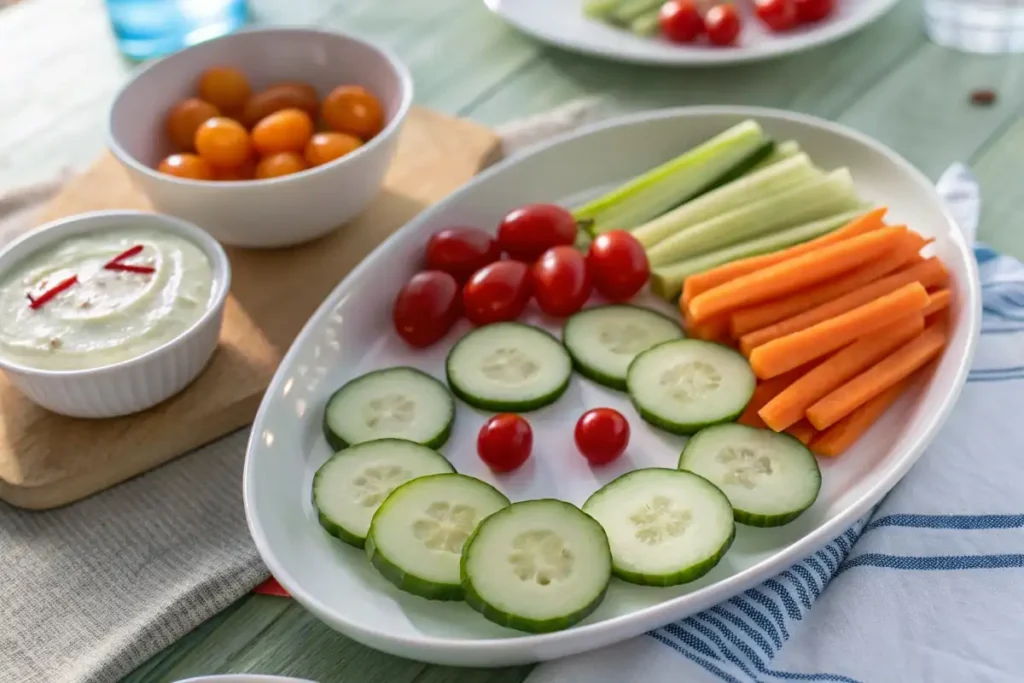
Getting kids to eat vegetables can be tricky, but a fun veggie tray can help. Consider arranging veggies into playful shapes, like a smiling face or an animal. Use carrot sticks for hair, cucumber slices for eyes, and cherry tomatoes for cheeks. Add a small bowl of ranch dip for “nose” or “ears.”
Bright colors and fun designs make the tray more appealing to little ones. Plus, when they’re involved in the creation process, they’re more likely to enjoy eating it.
Elegant Arrangements for Formal Events
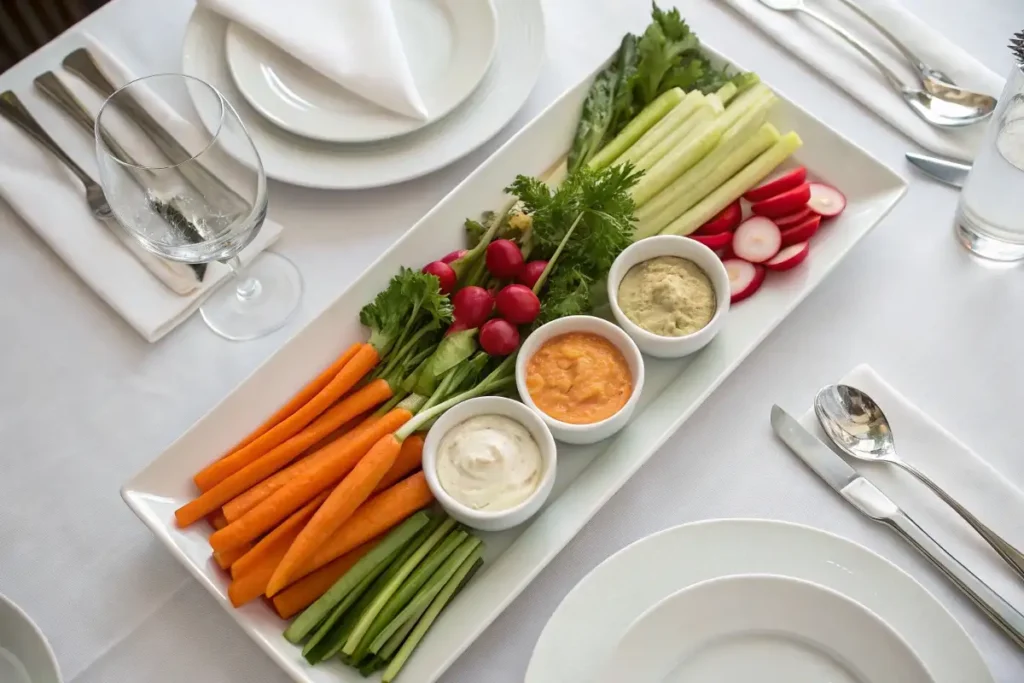
For more formal gatherings, opt for a sleek and elegant design. Stick to a minimalist layout, focusing on symmetry and neatness. Use a white platter to make the vibrant colors of your vegetables stand out. Pair the veggie tray with gourmet dips, like roasted red pepper hummus or a truffle-infused yogurt dip, to add a touch of sophistication.
Storing and Maintaining Freshness
Pre-Event Storage Tips
To keep your veggie tray fresh, prep your vegetables in advance but store them properly. After cutting, place them in airtight containers lined with damp paper towels to retain moisture. Refrigerate until you’re ready to arrange the tray.
If you’re using dips, prepare them a day ahead but store them separately to prevent the veggies from becoming soggy.
Keeping Vegetables Crisp During Events
During the event, serve your veggie tray on a chilled platter or over a bed of ice to maintain freshness. This is especially important for outdoor gatherings or warm environments. Check occasionally and replace any vegetables that appear dry or wilted.
Safe Handling Practices
Food safety is key when serving raw vegetables. Always wash your hands before handling food, and use separate cutting boards for vegetables and other items to avoid cross-contamination. These small steps go a long way in keeping your veggie tray fresh, safe, and enjoyable for everyone.
Addressing Common Concerns
Ensuring Food Safety
Serving a veggie tray means handling raw vegetables, so food safety is a must. Always start by washing all vegetables thoroughly under running water to remove dirt and bacteria. Use separate cutting boards for veggies and other foods, especially meat, to avoid cross-contamination. Additionally, keep your tray refrigerated until serving time to maintain freshness and prevent spoilage.
During the event, it’s wise to check the tray periodically. If it’s been out for more than two hours, replace the veggies with fresh ones to ensure safety and quality.
Accommodating Allergies and Sensitivities
Another concern when preparing a veggie tray is accommodating dietary restrictions. Luckily, most vegetables are allergy-friendly, but dips may contain allergens like dairy or nuts. To be safe, label your dips or keep allergen-free alternatives available, such as guacamole or salsa.
If any guests have severe allergies, ask them in advance about their needs. Taking this extra step shows thoughtfulness and ensures everyone can enjoy the tray.
Making Veggie Trays Appealing to All Ages
For kids or picky eaters, presentation is everything. Arrange veggies in fun shapes or patterns to catch their attention. For adults, including unique vegetables like snap peas or roasted peppers can elevate the tray. A mix of thoughtful design and diverse options keeps everyone coming back for more.
FAQs
Making your own veggie tray is usually cheaper than buying a pre-made one. Store-bought trays often come with a markup for convenience, packaging, and pre-cut vegetables. By purchasing fresh vegetables in bulk and preparing them yourself, you can save money while also customizing the selection to suit your taste and dietary preferences. Plus, homemade trays often look fresher and more appealing!
A veggie tray typically includes a mix of fresh, colorful vegetables that are easy to eat raw. Common choices are:
Carrot sticks
Celery sticks
Bell pepper strips (red, yellow, and green)
Cherry or grape tomatoes
Broccoli and cauliflower florets
Snap peas or green beans
Sliced cucumbers or zucchini You can also add unique options like radishes, asparagus, or roasted veggies for variety. A few dips, such as ranch, hummus, or guacamole, are usually included for added flavor.
Whether to peel cucumbers for your veggie tray depends on the type of cucumber and personal preference. English cucumbers, also called seedless cucumbers, have thin, edible skins that don’t require peeling. On the other hand, regular cucumbers often have thicker, waxed skins that can be tougher and may benefit from peeling. If you want a balanced look, consider peeling stripes (partially peeling the cucumber) for a decorative effect.
Yes, making your own party platters is almost always cheaper than buying pre-made ones. By shopping for ingredients at local markets or buying in bulk, you can significantly reduce costs. Additionally, homemade platters allow you to control portion sizes, use fresher ingredients, and tailor the selection to your guests’ preferences. While it requires a bit more effort, the savings and personal touch make it worth it.
Conclusion
Crafting the perfect veggie tray is simpler than you might think, and the results are always worth it. By combining fresh, colorful vegetables with delicious dips and thoughtful arrangements, you can create a healthy, crowd-pleasing centerpiece for any occasion. Whether you’re hosting a party, preparing a snack, or celebrating a special event, a veggie tray offers versatility, nutrition, and visual appeal. Don’t be afraid to get creative—experiment with seasonal veggies, themed designs, or unique dips to make your tray truly stand out. With these tips, you’ll have everyone reaching for seconds! Happy hosting!

